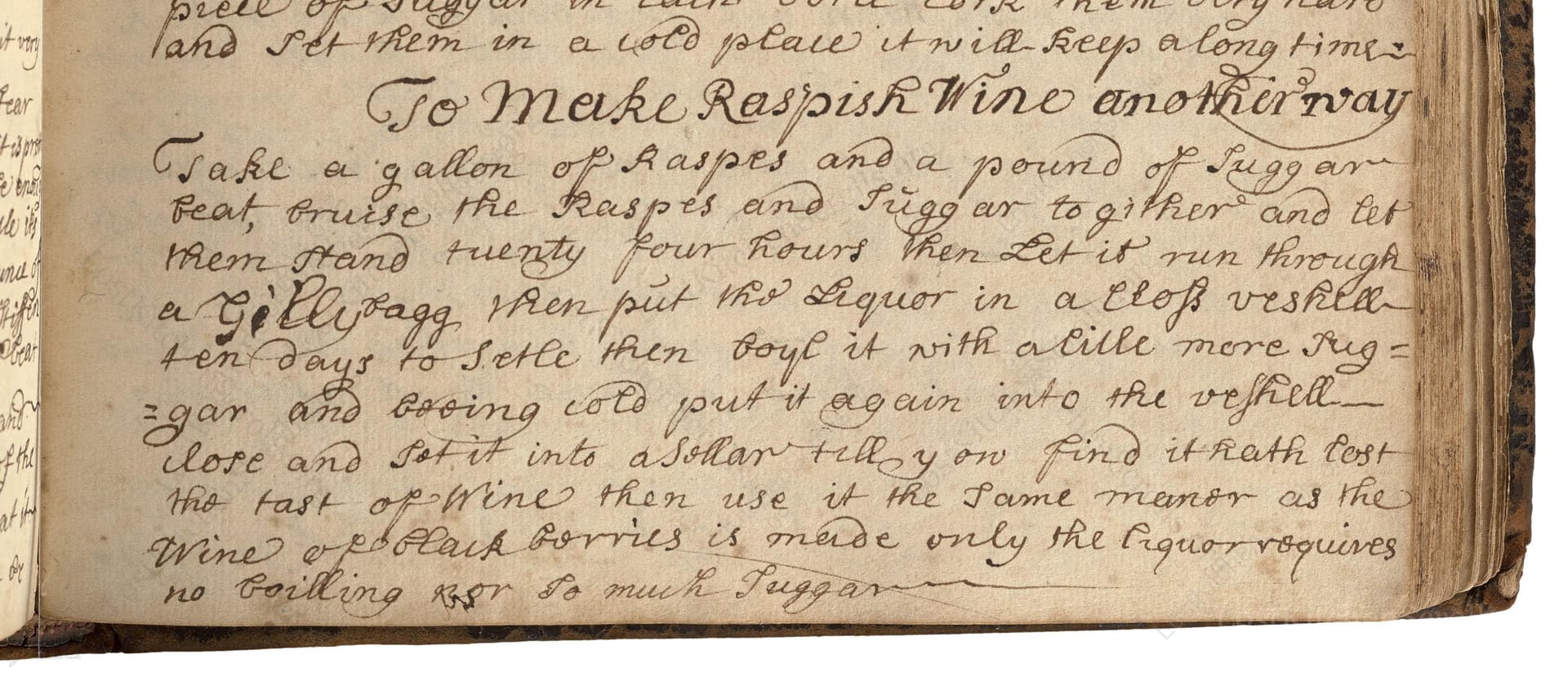To Make Raspish Wine Another Way
From the treasured pages of Cookbook
Unknown Author

To Make Raspish Wine Another Way
"Take a gallon of Raspes and a pound of suggar Beat Bruise the Raspes and suggar to gither and let them stand twenty four hours then let it run through a Gillybagg then put the Liquor in a closs vessell ten days to setle then boyl it with a little more suggar and beeing cold put it again into the vessell close and set it into a sellar till you find it hath lost the tast of wine then use it the Same maner as the wine of Black Berries is made only the liquor requires no boilling nor so much suggar"
Note on the Original Text
This recipe is written in a style typical of early 18th-century English manuscript cookery—punctuation is sparse, and spelling is phonetic (e.g., 'Raspes' for raspberries, 'suggar' for sugar, 'boyl' for boil, 'vessell' for vessel). Instructions are continuous and rely on the reader's prior knowledge. Measurements are imprecise but can be interpreted—'gallon' here refers to the older English (Queen Anne) gallon, about 4.5 liters. The language reflects a domestic, hands-on knowledge passed from cook to cook rather than commercial standardization.

Title
Cookbook (1706)
You can also click the book image above to peruse the original tome
Writer
Unknown
Era
1706
Publisher
Unknown
Background
Step back to the early 18th century with this charming culinary collection, brimming with period recipes that tantalize the tastebuds and offer a delicious glimpse into historic kitchens.
Kindly made available by
Folger Shakespeare Library
This recipe hails from England circa 1706, a period when homemade fruit wines were popular for both pleasure and medicinal purposes, especially among women managing household kitchens. The abundance of summer berries gave rise to various fruit wines, infusing everyday life with flavorful, low-alcohol drinks. Sugar was precious but increasingly available, allowing for such indulgences. Wine-making at home reflected the ingenuity of early 18th-century households, adapting available local produce to create shelf-stable beverages. Recipes like this offer a glimpse into the creativity and resourcefulness of early modern cooks.

In the early 1700s, cooks would have used a large ceramic or wooden bowl for mixing and mashing. The 'gillybagg' referred to a jelly bag, probably made of fine linen or muslin for straining. Fermentation and settling would occur in stoneware jars or glass bottles with waxed corks or wooden stoppers. A large hearth or stove would be used for boiling the liquid gently. Cellars were essential for cool, stable storage, aiding the wine’s maturation and keeping it safe from spoilage.
Prep Time
20 mins
Cook Time
10 mins
Servings
10
We've done our best to adapt this historical recipe for modern kitchens, but some details may still need refinement. We warmly welcome feedback from fellow cooks and culinary historians — your insights support the entire community!
Ingredients
- 1 gallon fresh raspberries (Rubus idaeus)
- 1 pound granulated sugar (white cane sugar)
- Additional 1/2 cup granulated sugar (for later boiling step)
Instructions
- Begin by taking about 1 gallon of fresh raspberries and combining them with 1 pound of granulated sugar.
- Gently mash the raspberries and sugar together, letting the mixture stand for 24 hours to draw out the juices.
- After this period, strain the mixture through a muslin cloth or fine sieve to colect the juice.
- Pour the juice into a clean, airtight container and let it settle in a cool place, such as a cellar or refrigerator, for 10 days.
- Once settled, bring the juice to a boil with an additional small amount of sugar (about 1/2 cup), alow it to cool completely, then return it to the clean vessel.
- Seal it tightly and let it mature in a cool, dark place until the sharp, raw taste diminishes and the flavors mellow, typically several weeks to months.
- At this point, the raspberry wine is ready to enjoy.
Estimated Calories
120 per serving
Cooking Estimates
You will spend about 20 minutes preparing the raspberries and sugar, then wait 24 hours for them to macerate. After straining, you'll need about 10 minutes for boiling and cooling. The wine will rest for about 10 days to settle and several weeks to mature. Each serving has around 120 calories, and this recipe makes about 10 servings.
As noted above, we have made our best effort to translate and adapt this historical recipe for modern kitchens, taking into account ingredients nowadays, cooking techniques, measurements, and so on. However, historical recipes often contain assumptions that require interpretation.
We'd love for anyone to help improve these adaptations. Community contributions are highly welcome. If you have suggestions, corrections, or cooking tips based on your experience with this recipe, please share them below.
Join the Discussion
Rate This Recipe
Dietary Preference
Main Ingredients

Den Bockfisch In Einer Fleisch Suppen Zu Kochen
This recipe hails from a German manuscript cookbook compiled in 1696, a time whe...

Die Grieß Nudlen Zumachen
This recipe comes from a rather mysterious manuscript cookbook, penned anonymous...

Ein Boudain
This recipe comes from an anonymous German-language manuscript cookbook from 169...

Ein Gesaltzen Citroni
This recipe, dating from 1696, comes from an extensive anonymous German cookbook...
Browse our complete collection of time-honored recipes



